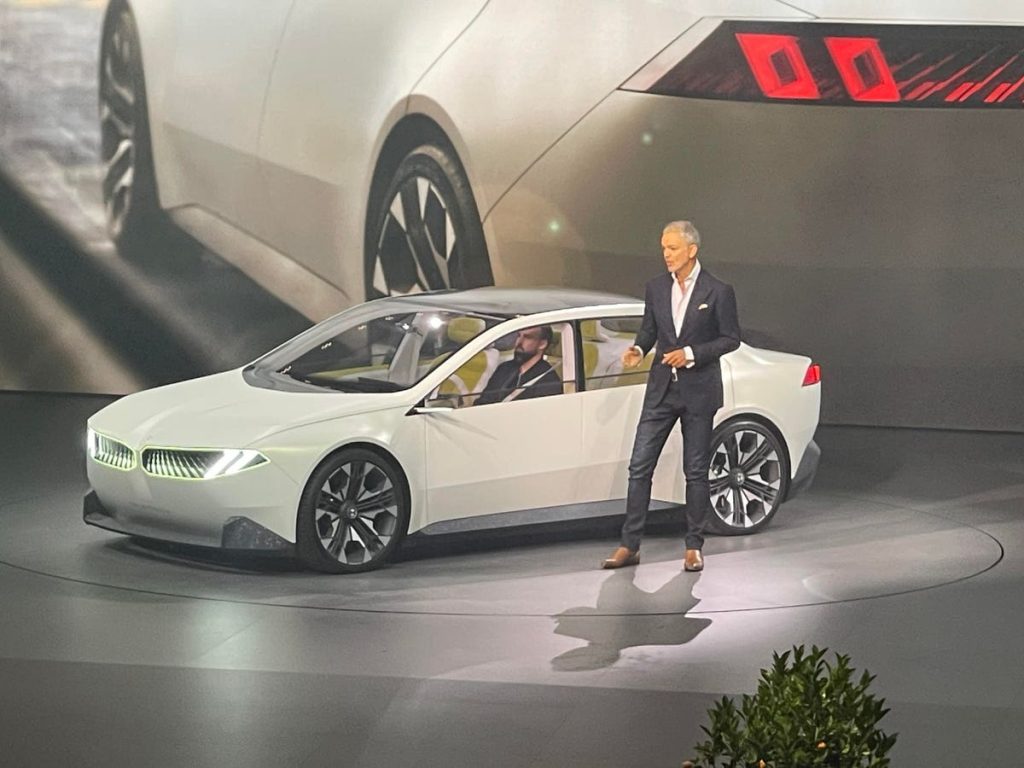BMW was one of the pioneers of EVs with the i3 and has been staging an electric comeback in the last couple of years with a whole range of new models. But the company has a lot more in store for an electrified sustainable automotive future. At the IAA Mobility show in Munich, BMW unveiled its Vision Neue Klasse, showcasing design and technology that it claims will be going into production in just a couple of years’ time.
The Vision Neue Klasse brings together two concepts BMW has been working on for the last few years. The BMW i Vision Circular was about a sustainable production lifecycle. The BMW i Vision Dee was about design and human experience. The BMW Vision Neue Klasse combines the two into one package that the company describes as “electrical, digital, circular”. BMW has been focusing on supply chain sustainability for a while now, but of course it is also a luxury performance car manufacturer, so design and core technology are paramount too.
The Neue Klasse name harks back to the original BMW Neue Klasse of the 1960s, and should probably be called the Neue Neue Klasse. BMW is hoping it will be as momentous as the strategy that spawned the 1800 and legendary 2002. Electrification is at the core this time, with no internal combustion variants, but BMW has also incorporated ideas from its i Vision Circular concept, such as a design that takes into consideration how the car will be dismantled at the end of its life and extensive use of recycled materials, alongside no leather or chrome in the interior. I particularly like the obvious recycled exterior trim on the prototype, making this a feature to be proud of rather than hide.
The design is very similar to the i Vision Dee. It has been stripped down to BMW essence, with a modern spin on some of the best features of the past and an end to the recent developments that have faced so much criticism. The classic BMW kidney grille has taken a much more aesthetic direction than the beaver teeth of current production models. The two halves of the kidney have been widened out to fill the entire front and now incorporate the lights and a digital screen called Phygital. This can communicate information and even track you round the car as you move to open the driver’s door.
The side has a strip of E Ink that can also communicate information. BMW has shown off entire vehicles covered in E Ink, which bears some resemblance to E Reader screen technology. It can alter the patterns and color on the exterior of the car dynamically. With the Vision Neue Klasse, it helps communicate things like where to wave your hand to open the door, which has a haptic system, so you don’t need to touch anything to unlock the catch.
The overall shape of the new car is far less angular than recent BMW models, with a flowing cabin and curved corners. The side profile strangely has echoes of the Alfa Romeo 166. Thanks to a structural battery (where the cells are incorporated into the chassis) and skateboard configuration, the cab starts much further forward than current BMW vehicles, providing more interior space.
Speaking of that interior, the headline act is the new iDrive system that BMW claims “combines real and virtual worlds”. This is a new integration of the user interface from the steering wheel to infotainment screen and BMW Panoramic Vision, which is a Head-Up-Display that is projected across the entire width of the windscreen. The passenger and driver can interact with this display, moving elements from the central screen to Panoramic Vision with a gesture. There is also BMW’s excellent HUD, which has gained 3D elements to provide key information to the driver without the need to look away from the road ahead. This is augmented by Alexa-powered voice control. Elements of this will be available in non-Neue Klasse BMWs as well, which will use the same core software and hardware computation platforms, which are now Android-based at their core as well as at the user interface level.
BMW focused greatly on the new user interface abilities of the Neue Klasse and new Mini Electric at the IAA Mobility 2023 launch. But there will be a major step forward in the underlying powertrain as well. The Neue Klasse will be based on BMW’s sixth generation eDrive technology, which the company claims will deliver 30% more range, 30% faster charging, and 25% more efficiency. This includes the sixth-generation battery with 20% greater density. However, no specific range or battery capacity figures were announced for the Vision Neue Klasse.
Dr Mike Reichelt, Senior Vice President for the Neue Klasse at BMW, told me this will be an 800V platform, enabling faster charging and greater efficiency. It will be battery chemistry agnostic. Initially it will use current NMC cells, but LFP could well feature in the future as well as other emerging chemistries. Vehicle to Grid (V2G) will also be supported, where the vehicle can return energy through its charging port and power a house or even be called upon as storage capacity to smooth out erratic power generation.
The Vision Neue Klasse appeared at the launch with great ceremony and drama. It looks incredible, the user interface technology is impressive, and BMW clearly wanted to emphasise how significant it would be to the future of the company. Of course, the first question everyone asks of concept cars is “will it go into production”. Oliver Zipse, BMW’s Chairman of the Board of Directors, claimed that production would start on cars based on the Neue Klasse in 2025, aligning with past statements. Although the prototype won’t be precisely what goes on sale – it lacks everyday essentials like cupholders, door pockets and adjustable seats – BMW said a shipping car would look like the prototype.
The Vision Neue Klasse on show at IAA Mobility 2023 will become the new 3-series class vehicle, and an X3-sized “Sports Activity Vehicle” (BMW’s version of the crossover SUV) was teased as well. But Dr Reichelt told me there will be at least six new vehicles based on the platform. Aside from the SAV, he was noncommittal about what these would be, other than stating they would range from compact to upper-mid-sized and luxury, but there were no denials when I suggested a Touring (estate car / station wagon) variant. If BMW can deliver on what it promised at the launch, this could be a very exciting era for the company’s cars.
Read the full article here









